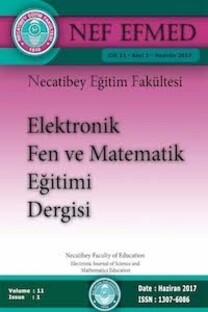Öğretmen Adaylarının Orantısal Olan ve Olmayan İlişkileri Belirleyebilme ve Temsil Edebilmelerinin Problem İçerikleri Açısından İncelenmesi
matematiksel temsiller, orantısal akıl yürütme, orantısal ilişkiler, öğretmen adayları, problem içeriği
Investigating Preservice Teachers’ Determination and Representation of Proportional and Nonproportional Relationships in Terms of Problem Contexts
mathematical representations, preservice teachers, problem context, proportional reasoning, proportional relationships,
___
- Author (2018). International Journal of Science and Mathematics Education.
- Author (2019). International Journal of Science and Mathematics Education.
- Cramer, K., & Post, T. (1993). Making connections: A case for proportionality. Arithmetic Teacher, 60(6), 342–346.
- Cramer, K., Post, T., & Currier, S. (1993). Learning and teaching ratio and proportion: Research implications. In D. Owens (Ed.), Research ideas for the classroom: Middle grades mathematics (pp. 159–178). New York, NY: Macmillan.
- Common Core State Standards Initiative (2010). The common core state standards for mathematics. Washington, D.C.: Author. http://www.corestandards.org/assets/CCSSI_Math%20Standards.pdf
- Degrande, T., Van Hoof, J., Verschaffel, L., & Van Dooren, W. (2017). Open word problems: Taking the additive or the multiplicative road?. ZDM, 50(1-2), 91–102. https://doi.org/10.1007/s11858-017-0900-6
- Fernández, C., Llinares, S., Modestou, M., & Gagatsis, A. (2010). Proportional reasoning: How task variables influence the development of students’ strategies from primary to secondary school. Acta Didactica Universitatis Comenianae Mathematics, 10, 1–18. http://hdl.handle.net/10045/16588
- Fisher, L. C. (1988). Strategies used by secondary mathematics teachers to solve proportion problems. Journal for Research in Mathematics Education, 19(2), 157–168. http://www.jstor.org/stable/749409
- Fraenkel, J. R., & Wallen, N. E. (2006). How to design and evaluate research in education (6th ed.). New York: NY, McGraw-Hill.
- Harel, G., & Behr, M. (1995). Teachers' solutions for multiplicative problems. Hiroshima Journal of Mathematics Education, 3, 31–51.
- Hsieh, H. F., & Shannon, S. E. (2005). Three approaches to qualitative content analysis. Qualitative health research, 15(9), 1277–1288.
- Izsák, A., & Jacobson, E. (2017). Preservice teachers’ reasoning about relationships that are and are not proportional: A knowledge-in-pieces account. Journal for Research in Mathematics Education, 48(3), 300–339. https://doi.org/10.5951/jresematheduc.48.3.0300
- Johnson, K. (2017). A study of pre-service teachers use of representations in their proportional reasoning. In Galindo, E., & Newton, J., (Eds.), Proceedings of the 39th North American Chapter of the International Group for the Psychology of Mathematics Education conference (pp. 551–558). Indianapolis, IN. https://files.eric.ed.gov/fulltext/ED581310.pdf
- Kaput, J. J., & West, M. M. (1994). Missing-value proportional reasoning problems: Factors affecting informal reasoning patterns. In G. Harel & J. Confrey (Eds.), The development of multiplicative reasoning in the learning of mathematics (pp. 235–287). Albany, NY: State University of New York Press.
- Kilpatrick, J., Swafford, J., & Findell, B. (2001). Adding it up: Helping children learn mathematics. Washington, DC: National Academy Press.
- Lamon, S. (2007). Rational numbers and proportional reasoning: Toward a theoretical framework for research. In F. K. Lester, Jr. (Ed.), Second handbook of research on mathematics teaching and learning (Vol 1, pp. 629–667). Charlotte, NC: Information Age Publishing.
- Lesh, R., Post, T., & Behr, M. (1988). Proportional reasoning. In J. Hiebert & M. Behr (Eds.), Number concepts and operations in the middle grades (pp. 93–118). Reston, VA: National Council of Teachers of Mathematics.
- Lim, K. (2009). Burning the candle at just one end: Using nonproportional examples helps students determine when proportional strategies apply. Mathematics Teaching in the Middle School, 14(8), 492–500.
- Lo, J. J. (2004). Prospective elementary school teachers' solution strategies and reasoning for a missing value proportion task. In M. J. Høines & A. B. Fuglestad (Eds.), Proceedings of the 28th International Group for the Psychology of Mathematics Education Conference (pp. 265–272). Bergen, Norway. http://emis.ams.org/proceedings/PME28/RR/RR207_Lo.pdf
- Lobato, J., & Ellis, A. (2010). Developing essential understanding of ratios, proportions, and proportional reasoning for teaching mathematics: Grades 6-8. National Council of Teachers of Mathematics. 1906 Association Drive, Reston, VA 20191-1502. https://eric.ed.gov/?id=ED511861
- Modestou, M., & Gagatsis, A. (2007). Students’ improper proportional reasoning: A result of the epistemological obstacle of “linearity”. Educational Psychology, 27(1), 75–92. https://doi.org/10.1080/01443410601061462
- National Council of Teachers of Mathematics (2000). Principles and standards for school mathematics. Reston, VA: Author.
- Orrill, C. H., & Brown, R. E. (2012). Making sense of double number lines in professional development: Exploring teachers’ understandings of proportional relationships. Journal of Mathematics Teacher Education, 15(5), 381–403. https://doi.org/10.1007/s10857-012-9218-z
- Patton, M. Q. (2005). Qualitative research. John Wiley & Sons, Ltd.
- Riley, K. R. (2010). Teachers’ understanding of proportional reasoning. In P. Brosnan, D. B. Erchick, & L. Flevares (Eds.), Proceedings of the 32nd annual meeting of the North American Chapter of the International Group for the Psychology of Mathematics Education (pp. 1055–1061). Columbus, OH: The Ohio State University
- Van Dooren, W., De Bock, D., & Verschaffel, L. (2010). From addition to multiplication… and back: The development of students’ additive and multiplicative reasoning skills. Cognition and Instruction, 28, 360–381. https://doi.org/10.1080/07370008.2010.488306
- ISSN: 1307-6086
- Yayın Aralığı: 2
- Başlangıç: 2007
- Yayıncı: Balıkesir Üniv. Necatibey Eğitim Fak.
ÇİĞDEM AKIN ARIKAN, FERİDE ÖZYILDIRIM GÜMÜŞ
Faik Özgür KARATAŞ, Canan CENGİZ, Şule Merve ULUDÜZ
Dinamik Geometri ile Keşif, Varsayım ve İspat Sürecinde Öğretmenin Rolü
Emel ÖZDEMİR ERDOĞAN, Abdulkadir ERDOĞAN, Zeliha DUR, Zeynep AKKURT DENİZLİ
Ortaokul Öğrencilerinin Zihin Haritalarının Belirlenmesi: “Dünya Ve Evren” Öğrenme Alanı
Canan NAKİBOĞLU, Ayşe Zeynep ŞEN
Rehberlik Öğretmenlerinin Bakış Açısıyla Okul Rehberlik Hizmetlerinde Yaşanan Sorunlar
